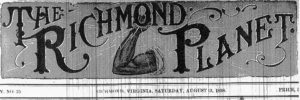
This is part 4 of the story (in 5 parts, plus one digression) of a white man who tried to glue together his life, sliced in two by the Civil War, by uniting in himself the most irretrievable parts of his past: master and slave. It’s a story that cobbles together, too, a paradox of American music — a paradox of music anywhere: that the exploitation of folk music by privilege is often the essence of its preservation. It’s the story of Polk Miller, “Negro delineator.”
POLK MILLER: 1 Roots | 2 “Old Plantation Negro” | 3 “Young Negroes” | 4 Rising Controversy | 5 Appropriation & Preservation | Cats & Dogs
White “negro delineators” billed as lecturers, dialecticians, or elocutionists continued to rove north and south, east and west, milking the eternal nostalgia for a simpler (mythical) past and the urge shared by whites and blacks to mix education and entertainment. The word “authentic” recurs in Miller’s publicity, assuring his audiences that he had the true means to smooth over the harsh paradoxes of a time that remains an open wound in America’s very heart. Of the quartet, Mark Twain said, “I think that Polk Miller, and his wonderful four, is about the only thing the country can furnish that is originally and utterly American.”
The wind was at Miller’s back, but that wind was changing direction. As death severed the living links to the past, American popular music moved on. The rising generation of whites and blacks pursued African American music within the more sophisticated jazz scene, not at folksy, age-tarnished re-enactments of by-gone days.
From Miller’s point of view, though, racism sabotaged his act. “Some of the Northern towns,” he said, “which wanted me would write, ‘We are exceedingly anxious to have you, but our people don’t want the quartet, as our people do not like the Negro.’”
In the lower South, violence against blacks was rising. Then, as now, working class whites functioned as scapegoats for racial tensions and Miller attributed his difficulties in the South to “a certain class of whites … whose ancestors never owned Negroes…. My solicitude for the comfort of my men, and many times for the safety of them … intensified my troubles when on the road and in some places I had to call on the police to guard my men.”
In Miller’s view, people who had never held slaves couldn’t possibly understand the status of the Quartette. “The better class of white people knew that I used these negroes for a purpose — to illustrate my work. They could see that my negroes knew what they were there for, as they entered heartily into the spirit of my work; that they were subservient to my will, but the commoner classes could not understand why Polk Miller, who posed as a gentleman, could bring a lot of ‘niggers’ there to entertain white people. The educational feature of my work … could not be seen by that class.”
Miller’s racist reasoning aside, it seems paradoxical that in the old Confederate capitol of Richmond, Virginia, a mixed-race act was well-received. Yet turn-of-the-century Richmond had achieved its own, paradoxical (and as it turned out, precarious) racial harmony. The neighborhood of the Richmond Planet offices, Jackson Ward, furnishes an example.
A long-established black neighborhood, in the early 20th century Jackson Ward came to be called “the Harlem of the South” and “the Black Wall Street.” Maggie Walker (1867–1934), the daughter of a formerly enslaved woman, was Jackson Ward’s most illustrious resident. She ran a newspaper, led a boycott against Richmond’s segregated streetcars, opened a large emporium on Richmond’s main shopping thoroughfare, and founded a bank, becoming the first woman bank president in the United States and providing financing for other Richmond African American businesses. Hers was not the only black-owned bank in Richmond, but it was the only one to survive the Depression.
White businessmen proved willing to help Walker and other African Americans achieve their ambitions; a white banker mentored Walker. In turn, blacks were expected to abide by what Douglas Southall Freeman called “separation by consent,” segregation not yet fully codified in law. 5 Appropriation & Preservation
Sources: Polk Miller’s scrapbooks and memorabilia. Collection of Valentine Richmond History Center. | Edison Phonograph Monthly, March 1910 | Anonymous, “Polk Miller and Negro Prejudice,” Richmond Evening Journal, January 4, 1912. Collection of Valentine Richmond History Center. | National Park Service, Maggie L. Walker National Historic Site. | Edison Phonograph Monthly, March 1910 | Brooks, Tim, and Dick Spottswood. “Polk Miller and His Old South Quartette.” In Lost Sounds: Blacks and the Birth of the Recording Industry, 1890-1919, 215-34. University of Illinois Press, 2004. | Joel Rose. “An Unlikely African-American Music Historian.” All Things Considered. National Public Radio. Nov 17, 2009.
Pingback:Polk Miller and "the young negroes"